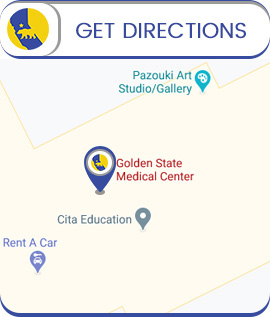Everything You Need to Know About Regenerative Medicine: Benefits, Process, and Recovery
Regenerative medicine aims to replace or repair damaged tissues, cells, and organs to get them back to normal. It encourages the body’s natural healing processes using cutting-edge therapies including tissue engineering and stem cell treatments. Our regenerative medicine program treats injured muscles, tendons, and other damaged tissues. Contact Golden State Medical Center, our qualified team would be pleased to help you get relief from your pain. We are conveniently located at 2551 San Ramon Valley Blvd. Suite 108. San Ramon, CA 94583. For more information, please contact us or request an appointment online.


Table of Contents:
Who is a good candidate for regenerative medicine?
What are the benefits of regenerative medicine?
What steps are involved in regenerative medicine therapy?
How long will it take for my illness to recover following regenerative medicine therapy?
Regenerative medicine has been finding new forms of effective treatment for conditions that cause pain, decrease mobility, and impact your active lifestyle. Treatments include stem cell therapy, prolotherapy, and platelet-rich plasma. These are good options to regenerate, restore, and rebuild damaged tendons, cartilage, and ligaments without the use of invasive surgery.
A good candidate for regenerative medicine is someone who has moderate osteoarthritis in the shoulder, hip, or knee. Regenerative medicine works well for ACL and meniscal tears. It has been beneficial for people with shoulder pain, labral or rotator cuff tears, and tendinitis. People with chronic pain in the neck, back sciatica, or non-healing fractures have also been good candidates for regenerative medicine.
This therapy treats other conditions, as well.
There are many benefits to working with regenerative medicine. Here are 5 benefits that truly stand out.
1. You may be able to avoid surgery. Stem cells and platelet-rich plasma therapy may help you reduce pain and avoid surgery. Both forms of regenerative medicine are used on torn rotator cuffs. This condition can be very painful and normally requires surgery to repair it. Regenerative medicine helps the body repair itself with minimally invasive treatment.
2. Recovery time is minimal. Most people can return to normal activities after a stem cell or PRP (platelet-rich plasma) therapy. These are both outpatient procedures with minimal side effects. Surgery requires time to heal and can also require physiotherapy. Regenerative medicine is much easier on the body and allows you to get back to your normal activities sooner.
3. Faster healing. Regenerative medicine helps people heal faster than conventional methods. Stem cells and PRP work to repair injured joints and tissue by enhancing the body’s ability to heal. It may take a few weeks to see a difference between regenerative methods and complementary therapies, but you will likely see a dramatic difference as you heal.
4. You won’t need medications or anesthetics. There is no need for general anesthesia or pain medications with regenerative medicine. The doctor can inject the stem cells or PRP in the precise area where it is needed. There is some nominal discomfort with the injection.
5. It is low risk since you are using your cells. When you use your cells to encourage healing, there is little risk involved. Cells from your own body are being used to stimulate their healing process.
Regenerative therapy is also called stem cell therapy. It promotes the repair response of injured, diseased, or dysfunctional tissues. Stem cells can be acquired from the body, most often from bone marrow. These can then be manipulated to become specialized cells that stimulate healing.
The stem cells are implanted into a person in the area that has been damaged, and they contribute to the healing of the damaged tissues.
The time it takes for someone to recover when using regenerative medicine therapy will depend on what is being treated and the patient’s ability to heal. Some people will start to see results in as little as 2 to 12 weeks. Pain relief that comes from regenerative medicine therapy can continue for a year or more. Aftercare is also a part of the healing process that can improve healing time. Working with the doctors, you can create a plan that will optimize your body’s healing.
Golden State Medical Center offers regenerative medicine that will get to the source of your condition. For more information on how we can help you with this amazing treatment, contact us or make an appointment. We are conveniently located at 2551 San Ramon Valley Blvd. Suite 108. San Ramon, CA 94583. We serve patients from San Ramon CA, Dublin CA, Blackhawk CA, Danville CA, Alamo CA, Diablo CA, Dougherty CA, Tassajara CA, Livermore CA, and Pleasanton CA.

Additional Services You May Need
▸ Physical Rehabilitation Therapy
▸ Auto Accident Injuries
▸ Massage Therapy
▸ Chiropractic
▸ Sports Injury Treatment
▸ Trigger Point Injections
▸ Hyaluronic Acid Injections
▸ Prolotherapy Injections
▸ Regenerative Medicine
▸ Platelet Rich Plasma (PRP) Therapy
▸ Advanced Corrective Care
▸ Back and Knee Bracing
▸ Hormone Optimization Therapy
▸ IV Therapy

Additional Services You May Need
▸ Physical Rehabilitation Therapy
▸ Auto Accident Injuries
▸ Massage Therapy
▸ Chiropractic
▸ Sports Injury Treatment
▸ Trigger Point Injections
▸ Hyaluronic Acid Injections
▸ Prolotherapy Injections
▸ Regenerative Medicine
▸ Platelet Rich Plasma (PRP) Therapy
▸ Advanced Corrective Care
▸ Back and Knee Bracing
▸ Hormone Optimization Therapy
▸ IV Therapy



